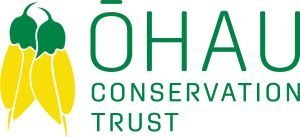It is now ten years since the first small group of keen but inexperienced volunteers were led out by Department of Conservation staff and introduced to the growing problem of “wilding” pines in the Lake Ōhau valley. Large landowners were removing substantial infestations of self-seeding conifers, but conservation land desperately needed attention too.
Since then that first modest group of perhaps a dozen enthusiasts has been joined by others until supporters now number more than fifty. They turn out not only on the Trust’s regular scheduled workdays but also in their own time. As well as pines, volunteers target broom, gorse, sweetbriar and lupins along roadsides as well as on public land.
Grants have also been received for planting native species, and hundreds of small beech, kowhais, hebes, coprosmas and tussocks are beginning to enhance the lakeside. Both the Alps 2 Ocean Cycleway and Te Araroa Walking Trail pass through the main areas worked on by the Trust. The Trust is also considering planting species with particular value to bees, of which this country has 28 native species, along with 13 introduced ones. In New Zealand as well as overseas, some farming practices have reduced the flowering species necessary for bees to thrive.
Trust members also collect seed from the Lake Ōhau valley and send it to the DoC Motukarara Plant Nursery near Christchurch. There they are grown and the seedlings are available for sale to members of the public who may want eco-sourced plants.
Hours put in at scheduled workdays and by Trust volunteers in their own time, amounts to a significant contribution to the environmental protection of the valley. During the last twelve months volunteers worked the equivalent of nineteen 40-hour weeks. Without this dedicated work over the past decade the Ōhau Valley today would look very different.
The Trust recognises many other conservation values of the valley, and moved into predator trapping to give our native bellbirds and fantails and other feathered friends a greater chance of survival. Astonishing numbers of ferrets have been caught in humane kill traps over just a 5 km length of lake shore, and the Trust plans to extend this programme.
Trust members recently took part in an Australian crested grebe survey. A pair regularly nests on Lake Middleton, choosing a nest site so close to the popular camping area that their breeding success most years is nil. Grebes are regularly seen on Lake Ōhau, but only one (thought to be one of a nesting pair) was seen on the day of the survey. They seem perhaps to favour the smaller bodies of water, although 77 were counted on Lake Benmore. 81 were counted on Lake Alexandrina and nine on Lake McGregor. Ruataniwha had six, the Wairepo Arm nine and the Kelland Ponds three. Overall these relatively rare birds seem to be slowly increasing in numbers around the South Island.
The water quality and the life within the lake itself is just as important as the land. Native fish, tiny galaxids, some of which are familiar to us as whitebait, breed in Ōhau’s mountain streams, though their access to these streams from the lake is often blocked by road culverts. Such culverts tend to become undercut at their exits, and the resulting overhanging lip is then an impassable barrier to fish travelling upstream. Scientists at Environment Waikato have discovered that galaxids can climb suitable ropes such as mussel spat rope. Installing this rope in culverts has been proven to enable fish to pass through. The Trust is currently investigating this possibility for Lake Ōhau.
Rainbow and brown trout were released in Lakes Ōhau and Middleton and many of the larger tarns in the 1890s, and both quinnat and sockeye salmon were established in the Waitaki River system over 100 years ago. Landlocked descendants of all these still inhabit Lake Ōhau. Ngai Tahu are now collaborating with native Americans who have come to this country with the aim of re-introducing the descendants of their own salmon back to their rivers of origin in California, where the worldwide problems of water over-use and pollution, along with a huge hydro dam on the McLeod River that blocks migration, have led almost to their extinction.
Another significant inhabitant of Lake Ōhau and the upper Waitaki River is the longfin eel. The longfin is indigenous to New Zealand and precious to the Maori people. The species is officially listed as endangered, and is threatened by dams, overfishing and degradation of habitat. Since the commissioning of the Waitaki dam in 1935, migration to and from the sea has been blocked for both eels and salmon. Members of the Waitaki Native Fish Committee, supported by Meridian Energy, now catch mature female longfin eels above the Waitaki dams and transfer them past the lethal hydro turbines that would end their final migration to sea and the Tonga Trench where they spawn 6,000 km away. These females can be more than 100 years old, so their life cycle is a very long one. Committee members then gather up the tiny returning elvers whose passage back up river is blocked by the Waitaki dam, and transfer them up to Lake Benmore. It’s hoped that fund raising may eventually enable the establishment of fish passes on all the Waitaki River dams. The Trust has resolved to support the Native Fish Committee in their endeavours, and all profits from this year’s fund raising dinner on 3 May 2014 will go to the Committee.
